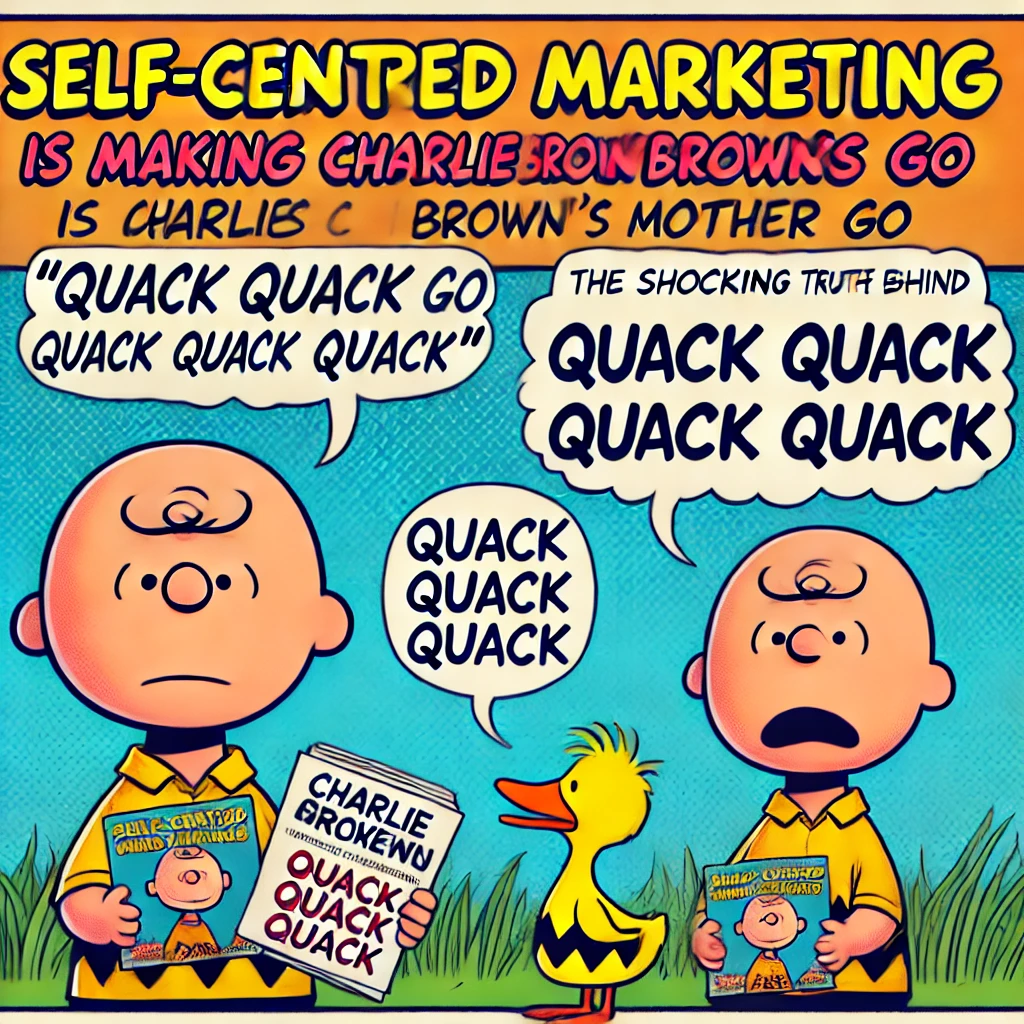Self-Centered Marketing Is Making Charlie Brown’s Mother Go “Quack Quack Quack”: The Shocking Truth Behind Your Failed Campaigns
Let me guess: you’ve spent countless sleepless nights obsessing over your marketing strategy. You’ve poured money into slick campaigns, hired the “best” agencies, and chased every trending platform. And yet? Crickets. Your conversion rates look like a flat line on a heart monitor, engagement metrics make you want to hide under your desk, and that elusive ROI feels like chasing a mirage in the desert. Been there. The gap between what you’re spending and what you’re getting back isn’t just annoying—it’s the kind of thing that makes CEOs wake up in cold sweats at 3 AM.
As a digital marketing strategist who has guided countless businesses through transformative growth, I’ve identified a fundamental misstep that derails most marketing campaigns. The issue is not with your budget, platforms, or even your product. It’s with your perspective—a perspective that, once shifted, can dramatically alter your marketing effectiveness.
The Core Problem: You’ve Made the Fatal Mistake of Self-Centered Marketing
Review your current marketing materials. Do they predominantly feature phrases like “our innovative solution,” “our industry-leading expertise,” or “our state-of-the-art technology”? Are your social media posts filled with company announcements rather than customer victories? Does your website talk extensively about your company history rather than customer transformations? If so, you’ve identified your problem.
The hard truth that many businesses struggle to accept is this: from your market’s perspective, you are irrelevant.
Your potential customers don’t wake up thinking about your company. They don’t care about the intricacies of your operations or the accolades you’ve accumulated. What they care about is solving their problems and achieving their objectives.
Payment Fatigue – It’s Your Marketing ROI Running Away
Think about Charlie Brown’s mother in the Peanuts comics. We never see her, but we hear her distinctive “Quack Quack Quack” voice in the background. That’s exactly how your customers perceive your self-centered marketing messages—as indistinct noise they’ve learned to tune out.
Every time you blast another “we’re the best” campaign into the void, your potential ROI screams and runs further away. And who can blame it? When your messaging focuses exclusively on your greatness rather than your customers’ needs, you’re essentially having a one-sided conversation with yourself.
Real-World Example: The Tale of Two Software Companies
Consider the contrasting approaches of two software companies in the project management space:
Company A marketed themselves as “the industry’s most sophisticated project management solution with proprietary algorithms developed by our team of PhDs.” Their website featured pages about their development process, technical specifications, and company milestones. Despite spending $50,000 monthly on marketing, their conversion rate stagnated at 1.2%.
Company B took a different approach. Their messaging focused on “helping busy teams complete projects 30% faster with less stress.” Their website featured case studies showing how specific customers overcame deadline challenges, reduced team burnout, and impressed their stakeholders. Their marketing materials addressed common pain points like missed deadlines, communication gaps, and resource allocation struggles. With a smaller $30,000 monthly budget, they achieved a 4.8% conversion rate.
The difference? Company B understood that effective marketing isn’t about showcasing your brilliance—it’s about demonstrating your relevance to your customers’ success stories.
The $100,000 Mistake: When “Award-Winning” Means “Customer-Losing”
I recently consulted with a tech startup that had invested over $100,000 in a rebranding campaign centered around their “award-winning innovation” and “revolutionary approach to data management.” Their new website prominently featured their founder’s inspiring journey, their impressive office space, and the numerous industry accolades they’d received.
Six months and zero measurable growth later, we completely overhauled their approach. We replaced their self-congratulatory content with customer-focused messaging that addressed specific pain points their target audience experienced. We transformed their case studies from technical showcases to customer victory stories.
The results were immediate and dramatic: a 215% increase in qualified leads within 90 days and a 37% higher conversion rate on their core offering.
The Shift That Changes Everything: From Company Hero to Customer Guide
Effective marketing requires a radical perspective shift. Instead of positioning your business as the hero of the story, position your customer as the protagonist and your business as the empowering guide.
When you reframe your messaging to demonstrate how you help your customers overcome challenges and achieve success, something remarkable happens. You transform from an irrelevant entity vying for attention into a valuable ally in your customer’s journey.
This isn’t just theoretical—businesses that make this shift consistently outperform their competitors across industries:
- A financial services firm that switched from promoting their “40 years of investment expertise” to showing “how everyday families are achieving college funding and comfortable retirement” saw lead generation increase by 78% within one quarter.
- A healthcare technology company that shifted from highlighting their “advanced AI diagnostic platform” to emphasizing “how physicians are reducing misdiagnosis rates and improving patient outcomes” doubled their demo requests within 60 days.
The “Me-Me-Me” Marketing Epidemic: Are You Infected?
Self-centered marketing has reached epidemic proportions, particularly in crowded industries where companies struggle to differentiate themselves. The symptoms are easy to identify:
- Headlines focused on company achievements rather than customer outcomes
- Content that starts with “We are proud to announce…” instead of “You can now achieve…”
- Case studies that emphasize technological capabilities rather than human impact
- Testimonials that spotlight your excellence instead of customer transformation
- Metrics that track company growth rather than customer success
If your marketing exhibits three or more of these symptoms, you’re suffering from what I call “Me-Me-Me Marketing Syndrome.” The good news? It’s entirely curable.
Practical Steps to Customer-Centric Marketing That Drives Results
1. Map Your Customer’s Journey in Detail
Before creating any marketing material, develop comprehensive buyer personas and journey maps. Understand their specific:
- Pain points: What keeps them up at night?
- Aspirations: What does success look like to them?
- Obstacles: What prevents them from achieving their goals?
- Decision criteria: What factors influence their purchasing decisions?
Example in Action: A B2B logistics company interviewed 50 potential clients to identify their top challenge—unpredictable delivery timelines that created inventory management nightmares. They restructured their entire marketing message around “bringing predictability to your supply chain,” resulting in a 45% increase in qualified leads.
2. Speak Their Language, Not Your Industry Jargon
Replace technical jargon with terms that resonate with your audience’s everyday experiences. Mirror the exact phrases and terminology your customers use when describing their challenges.
Example in Action: A cybersecurity firm replaced messaging about their “advanced threat detection algorithms and network perimeter protection” with “helping you sleep at night knowing your customer data is safe.” Their email open rates jumped from 15% to 32%, and click-through rates doubled.
3. Showcase Transformation Through Concrete Examples
Rather than listing features, illustrate the before-and-after scenarios that your customers experience. Use specific metrics and tangible outcomes that your target audience will immediately recognize as valuable.
Example in Action: A productivity app stopped marketing their “15 innovative features” and instead created a campaign showing how “busy professionals reclaim 5+ hours weekly.” They included day-in-the-life comparisons showing the transformation from chaotic to controlled workdays. App downloads increased by 67% during the campaign.
4. Let Customers Tell Your Story Through Strategic Testimonials
Authentic testimonials that highlight specific outcomes carry far more weight than self-promotion. Structure these stories to emphasize the customer’s journey, with your product or service playing a supporting role in their success.
Example in Action: A marketing agency stopped publishing generic client testimonials saying they were “great to work with” and instead created in-depth case studies showing exactly how specific clients increased their conversion rates by 42%, grew organic traffic by 156%, and secured 28% more qualified leads. Prospective client inquiries increased by 93% in the following quarter.
5. Measure What Matters to Them, Not Just to You
Define success metrics based on customer-centric outcomes rather than company-centric metrics. Track and report on the metrics that reflect actual customer success, not just your marketing performance.
Example in Action: A SaaS platform shifted their reporting dashboard from emphasizing “number of users” and “features utilized” to tracking “time saved per user” and “business goals achieved.” This shift not only improved their marketing messaging but also reduced churn by 23% as customers began to recognize concrete value.
The Wake-Up Call: Your Last “We’re Awesome” Press Release Got Zero Leads
I recently asked a room full of marketing executives this simple question: “When was the last time your company announcement or press release directly generated qualified leads?”
The uncomfortable silence spoke volumes.
The hard truth is that traditional self-promotional content rarely moves the needle on metrics that matter. Yet companies continue to invest significant resources creating and distributing this type of content, often at the expense of customer-centric alternatives that actually generate results.
One manufacturing client replaced their quarterly company update emails with customer success story newsletters. The open rate tripled, and each issue now generates an average of 15 qualified sales conversations—something their company announcements had never accomplished.
The Ultimate Marketing Litmus Test That Never Fails
Before launching any marketing initiative, ask yourself these critical questions:
- Does this clearly demonstrate how we help our customers win?
- Does this address a specific pain point our audience experiences?
- Does this show the transformation our customers can expect?
- Would our customers see themselves as the hero in this narrative?
If the answer to any of these questions is anything less than an emphatic “yes,” it’s time to recalibrate.
Beyond Theory: Putting Customer-Centricity into Practice
Here’s a simple exercise to begin the transformation: Take your current primary marketing piece—whether it’s your homepage, your sales deck, or your primary advertisement—and highlight every instance of “we,” “our,” and “us.” Then highlight every instance of “you,” “your,” and direct references to customer outcomes.
The ratio should heavily favor the latter. If it doesn’t, you’ve discovered a critical opportunity for improvement.
The Marketing Mirror Test: Brutal but Necessary
One of my most effective consulting techniques involves what I call “The Marketing Mirror Test.” We take a company’s marketing materials and present them to potential customers without revealing the company name. We then ask one simple question: “Based on this material, what problem does this company solve for people like you?”
The results are often sobering. When marketing focuses primarily on company achievements and capabilities, customers struggle to articulate the value proposition. When marketing centers on customer challenges and outcomes, the value proposition becomes immediately clear—even without brand recognition.
A regional insurance broker was shocked when 7 out of 10 participants in their mirror test couldn’t identify what specific problem the company solved. After refocusing their messaging on customer pain points and outcomes, that number dropped to zero—every participant could clearly articulate the company’s value proposition.
Stop Making Charlie Brown’s Mother Quit on Your Marketing
Remember those “Quack Quack Quack” sounds representing Charlie Brown’s mother? That’s what self-centered marketing sounds like to your prospects. It’s background noise they’ve learned to ignore.
But when you speak directly to their challenges, aspirations, and desired outcomes, they suddenly perk up. They lean in. They engage. Because unlike Charlie Brown’s mother, who never appears on screen, you’ve finally made your customers the visible protagonists of your marketing story.
The Bottom Line: Make Them the Hero, Be Their Guide
When your marketing genuinely focuses on making your customers the heroes of their own stories—with your business playing the crucial supporting role—you’ll discover that relevance, engagement, and conversions naturally follow.
In today’s market, businesses that understand this fundamental truth don’t just survive—they thrive. The question is, are you ready to step out of the spotlight and start shining it on your customers instead?
Remember, the most powerful marketing truth remains elegantly simple: You only matter when you can show your audience how you help them win.
Master this principle, and watch your marketing transform from an expensive necessity to a powerful growth driver.



